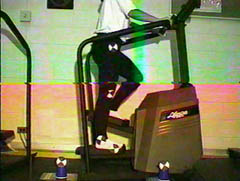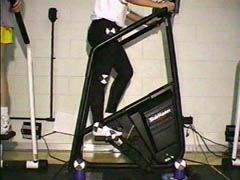 |
 |
 |
 |
There are currently two popular stair-climbing fitness machines in use in the CCRB, the University of Michigan's student fitness facility, as well as numerous other gyms. They are the StairMaster and the LifeStep. The StairMaster is constructed of two small foot pedals, which are attached to a chain, and requires constant movement in order to keep the pedals from coming in contact with the floor. In contrast, the LifeStep has larger foot pedals and the resistance is controlled by hydraulic pumps. The main difference in construction between the two is that the LifeStep doesn't require the user to be in constant motion. The movement of one pedal is dependent upon the movement of the opposite pedal, and the relationship of their movement is inverse. We would like to study the differences in the human kinesiology between the two machines. There appears to be a more extreme knee angle and ankle range of motion with the LifeStep. A more extreme knee angle would put an added stress on the patellar tendon due to the contraction of the quadriceps and the pulling of the patella towards the femur. A person with arthritis and chondromalacia may notice more pain and discomfort with use of the stair-climbing machine with the more extreme knee angle. It is proven safe for an individual with arthritic conditions to perform moderate level exercise on such a machine as a stairclimber. It is often known to lead to some relief of pain and disability (Ettinger, 1998). We would like to evaluate the how the LifeStep knee angles compare to the Stairmaster knee angles in order to see which model of machine is better suited for someone with knee injuries and pathologies.
Since there is currently no research comparing of the two stair climbers, we are interested in evaluating the ankle and knee joint angles to determine if one machine provides a safer and/or more effective exercise program in regards to the knee and ankle joint.